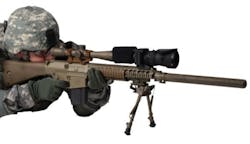Sarnoff and HRL Laboratories to develop photonic integrated circuits to enable video-like phased-array LIDAR
ARLINGTON, Va., 13 Feb. 2010.Military electro-optics scientists at two U.S. technology companies are trying to revolutionize scanning-laser sensors in the same way that phased-array technology transformed radar, by providing a compact, agile alternative to mechanically steered technology that will provide video frame rate beam steering speeds for applications like surveillance, 3D imaging, precision targeting, munitions guidance, navigation, and low-probability-of-intercept communications.Scientists at SRI International Sarnoff in Princeton, N.J., and HRL Laboratories LLC in Malibu, Calif., are developing new methods of active optical beam steering and sensing as part of the Short-range Wide-field-of-view Extremely-agile Electronically-steered Photonic EmitteR (SWEEPER) program of the U.S. Defense Advanced Research Projects Agency (DARPA) in Arlington, Va.Officials of the DARPA Microsystems Technology Office last week awarded Sarnoff an $8.5 million contract, and HRL a $14.3 million contract for the SWEEPER project, which seeks to enable scanning laser sensors such as LIDAR to scan quickly enough produce moving video-like imagery based on reflected laser light.
Sarnoff and HRL will develop active optical beam steering and sensing by developing chip-scale integrated photonic coherent beam-forming technologies that overcome the limits of opto- mechanical and electro optical systems in small packages.
DARPA envisions that a SWEEPER program will establish photonic integrated circuit (PIC) technology that will provide video frame rate beam steering speeds, and emit several beams with a total output power of 10 Watts.
Scanning laser sensors have been in use for several years. These systems often are called light direction and ranging (LIDAR), or laser direction and ranging (LADAR). The mechanisms that scan these beams have proven to be weak points until now, because scanning has been mostly restricted to opto-mechanical, acousto-optical (AO) or electro-optical (EO) techniques.
Opto-mechanical scanning devices are usually bulky and relatively slow, while AO and EO use small devices that cannot provide the steering speeds and versatility necessary for many applications, DARPA officials explain.
To compensate for these shortcomings, the SWEEPER program seeks to extend phased array beam steering to the optical domain in the near infrared spectrum -- the 0.8-to-2-micron optical range -- by developing photonic integrated circuits for optical phased arrays, which will integrate thousands of closely packed optical emitting facets, precise relative electronic phase control of these facets, and all within a small form factor, DARPA officials say.
For more information contact SRI International Sarnoff online at www.sarnoff.com, HRL Laboratories at www.hrl.com, or the DARPA MTO at www.darpa.mil/MTO.

